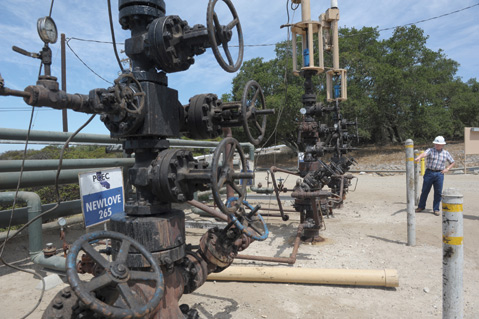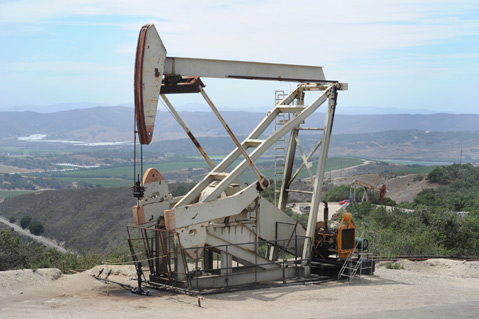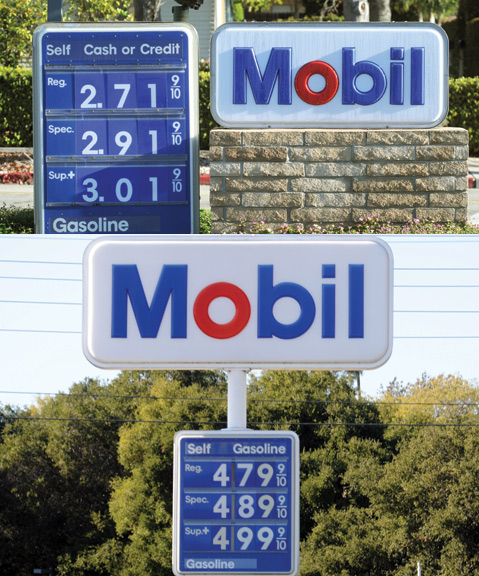Cheap Gas, but Pricey Futures
Can OPEC Shake Out Santa Barbara Oil Operators?

Last June, after the Water Guardians waged a swift movement to get Measure P placed on the ballot, the price per barrel of oil was $105. Five months later, after producers in Santa Barbara County launched a well-funded and concise counterattack to defeat the drilling ban, worldwide prices had tumbled to $65.
Throughout the last election season, supporters of Measure P argued it would stanch future oil development, namely the increasingly popular — and what they said was increasingly risky — cyclic steam injection method. Opponents alleged Measure P would mean an end to the entirety of the oil industry here and certainly an end to their plans for steam injection wells.
Now, two months post-Election Day, the price per barrel of oil has plunged to $46, only three dollars more than it cost in the throes of the recession in 2009. The average gallon of gas in Santa Barbara costs $2.63, but, as of Tuesday, it was as low as $2.45 at some pumps (with the notable exception of Glen Annie). But what comes as good news for drivers — industry analysts predict $40 per barrel before OPEC puts on the brakes — could be bad news for domestic operators.

Will OPEC Accomplish Measure P’s Goal?
If a widely held theory is to be believed, an adverse effect on expensive U.S. production is precisely the endgame for OPEC (a k a Organization of the Petroleum Exporting Countries). With a surge of Middle Eastern oil flooding the market, coinciding with ramped-up production in the United States, market forces could take smaller American operators out of the picture. A boom-and-bust industry by nature, oil could rally by the end of the year, those same soothsayers say, if prices rose to $65 or $70 per barrel. But to get there, production has to drop.
Kevin Drude, head of the county’s Energy Division, has applications for 329 cyclic-steaming wells on his desk — the county approved 184 in the last 12 months — and is awaiting a rumored application for 300 more. Whether area producers scale back future bids — none of the existing ones have been tweaked yet — won’t be known for at least a few more months, Drude said.
Cyclic steaming — in which steam is injected 1,000 feet underground to coax oil out of the diatomite layer — comes at a higher cost than other drilling techniques, Drude said. Compared to the “free-flowing, watery oil” pumped out of Middle Eastern earth, it takes “a lot of energy and money” to extract from the diatomite, Drude explained, adding that the infrastructure required for the process isn’t cheap. “It’s tough times out there,” Drude said.
Three Santa Barbara County producers could face tough times ahead. Officials for Santa Maria Energy, Pacific Coast Energy Company, and ERG Operating Company all answered that their plans are moving forward, but how they weather another 11 months of a depreciating market remains a large question.
A Unique Case
With the cost to drill one new cyclic-steaming well ranging, Drude said, anywhere from $1 million-$15 million, most industry experts agree the best way to tackle a new project is to do it in phases, to allow existing operations to foot the bill for new work. Santa Maria Energy (SME), Drude said, is “unique” in that it has some infrastructure associated with its 26-well pilot project, but it needs two new, bigger steam generators for its additional 110 wells.
The company’s timeline to drill the new wells — the cost of which will be closer to the low end of those millions mentioned — looks a couple of years out, said Bob Poole, the company’s public and government affairs manager. The pilot wells at its Orcutt field help, Poole said, adding that each yields up to 10 barrels per day; the company also operates about 60 conventional wells, which produce about the same.
A yield of up to 3,300 barrels per day is projected for SME’s 136-well project. Its controversial approval in November 2013 paved the way for the company to tap into an estimated 15.6 million barrels in its diatomite reserve.
Financial information for the oil companies is hard to come by, but that figure, along with the approximately $99 million in assets held by SME as of 2013, was listed in a Securities and Exchange Commission filing from Santa Maria Energy’s now-abandoned plans to merge with an investment firm last year. Poole said the company, which has a hefty investor in Kayne Anderson Capital Advisors, is still seeking “additional capital opportunities.” A previous estimate of the company’s capital needs, $100 million-$125 million, is “within the ballpark still,” Poole said.
Another cost is $8 million for an eight-mile recycled-water pipeline. For now, Poole said, Santa Maria Energy, which employs about 80 full-time staff and contractors, is “hunkered down” to finalize its permits. Any contingency plans to adapt to the volatile oil market could involve delays, he said, adding that SME has “some bread and butter” but “not a whole loaf” yet. “From our perspective, we’re doing okay,” Poole said. “Obviously, we’re hoping the market will stabilize itself.”

Waiting Game
It’s a similar sentiment next door to SME’s fields, which is where Pacific Coast Energy Company (PCEC) has 96 cyclic steam injection wells and 200-something traditional wells. They currently pump out 3,300 barrels daily. “It is a cycle. I anticipate at some time the cycle will swing back, but when that is I could not tell you,” said Jim Bray, PCEC’s public and government affairs manager.
PCEC’s application for 96 more cyclic-steaming wells — at the environmental-analysis stage at the county — should come before decision makers this summer, said Bray, and the “efficiency” of having preexisting infrastructure is giving the company some peace of mind. PCEC, which led the regional fundraising charge against Measure P and employs 250 staff and contractors, recently staked a claim to up to 17.2 million barrels underground. PCEC, the only public energy company in the area, has had its stock swing from a high of $14.25 per share to a low of $4.96 in the last year.
The 233 cyclic-steaming-well project proposed last year by ERG is in the earliest of stages, Drude said, adding that a three-mile oil pipeline — meant to reduce truck traffic and, possibly, provide a transport system other operators could buy into — will go to the county’s Planning Commission in the next couple of months.
Although he noted a decrease in employees from 400 last year to just above 80 now, John Deacon — ERG’s manager of environmental, safety, and regulatory compliance — said the company remains optimistic, anticipating the 233-well project will be decided by the end of 2015 or early 2016. The company — which operates 300-plus cyclic-steaming wells and approximately 200 conventional wells, producing about 2,500 barrels of oil daily — already has two steam generators and another one permitted; four more are in the application.
The Houston, Texas–based company saw its financial future brighten last year, when a Chinese jewelry company offered to buy it, and let ERG retain management, for $665 million. That sale is still pending, Deacon said, adding that in his 30 years in the industry, he has seen dips in the price of oil before. “It always comes back,” he said. “Sometimes it takes a while.”



